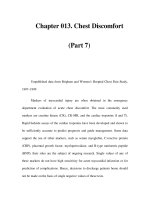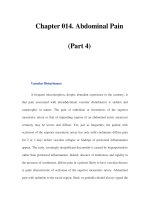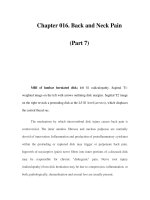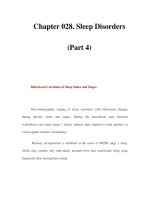Chapter 049. Sexual Dysfunction (Part 7) ppsx
Bạn đang xem bản rút gọn của tài liệu. Xem và tải ngay bản đầy đủ của tài liệu tại đây (14.11 KB, 5 trang )
Chapter 049. Sexual
Dysfunction
(Part 7)
Physiology of the Female Sexual Response
The female sexual response requires the presence of estrogens. A role for
androgens is also likely but less well-established. In the CNS, estrogens and
androgens work synergistically to enhance sexual arousal and response. A number
of studies report enhanced libido in women during preovulatory phases of the
menstrual cycle, suggesting that hormones involved in the ovulatory surge (e.g.,
estrogens) increase desire.
Sexual motivation is heavily influenced by context, including the
environment and partner factors. Once sufficient sexual desire is reached, sexual
arousal is mediated by the central and autonomic nervous systems. Cerebral
sympathetic outflow is thought to increase desire, while peripheral
parasympathetic activity results in clitoral vasocongestion and vaginal secretion
(lubrication).
The neurotransmitters for clitoral corporal engorgement are similar to those
in the male, with a prominent role for neural, smooth muscle, and endothelial
released nitric oxide (NO). A fine network of vaginal nerves and arterioles
promote a vaginal transudate. The major transmitters of this complex vaginal
response are not certain, but roles for NO and vasointestinal polypeptide (VIP) are
suspected. Investigators studying the normal female sexual response have
challenged the long-held construct of a linear and unmitigated relationship
between initial desire, arousal, vasocongestion, lubrication, and eventual orgasm.
Caregivers should consider a paradigm of a positive emotional and physical
outcome with one, many, or no orgasmic peak and release.
Although there are the obvious anatomic differences as well as variation in
the density of vascular and neural beds in males and females, the primary effectors
of sexual response are strikingly similar. Intact sensation is important for arousal.
Thus, reduced levels of sexual functioning are more common in women with
peripheral neuropathies (e.g., diabetes). Vaginal lubrication is a transudate of
serum that results from the increased pelvic blood flow associated with arousal.
Vascular insufficiency from a variety of causes may compromise adequate
lubrication and result in dyspareunia. Cavernosal and arteriole smooth-muscle
relaxation occurs via increased nitric oxide synthase (NOS) activity and produces
engorgement in the clitoris and surrounding vestibule. Orgasm requires an intact
sympathetic outflow tract; hence, orgasmic disorders are common in female
patients with spinal cord injuries.
Approach to the Patient: Female Sexual Dysfunction
Many women do not volunteer information concerning their sexual
response. Open-ended questions in a supportive atmosphere are helpful for
initiating a discussion of sexual fitness in women who are reluctant to discuss such
issues. Once a complaint has been voiced, a comprehensive evaluation should be
performed, including a medical history, psychosocial history, physical
examination, and limited laboratory testing.
The history should include the usual medical, surgical, obstetric,
psychological, gynecologic, sexual, and social information. Past experiences,
intimacy, knowledge, and partner availability should also be ascertained. Medical
disorders that may impact sexual health should be delineated. These include
diabetes, cardiovascular disease, gynecologic conditions, obstetric history,
depression, anxiety disorders, and neurologic disease. Medications should be
reviewed as they may impact arousal, libido, and orgasm. The need for counseling
and life stresses should be identified. The physical examination should assess the
genitalia, including clitoris. Pelvic floor examination may identify prolapse or
other disorders. Laboratory studies are needed, especially if menopausal status is
uncertain. Estradiol, FSH, and LH are usually obtained, and
dehydroepiandrosterone (DHEA) should be considered as it reflects adrenal
androgen secretion. A complete blood count, liver function assessment, and lipid
studies may be useful, if not otherwise obtained. Complicated diagnostic
evaluation, such as clitoral Doppler ultrasonography and biothesiometry, require
expensive equipment and are of uncertain utility. It is important for the patient to
identify which symptoms are most distressing.
The evaluation of FSD previously occurred mainly in a psychosocial
context. However, inconsistencies between diagnostic categories based on only
psychosocial considerations, and the emerging recognition of organic etiologies,
has led to a new classification of FSD. This diagnostic scheme is based on four
components that are not mutually exclusive: (1) Hypoactive sexual desire—the
persistent or recurrent lack of sexual thoughts and/or receptivity to sexual activity,
which causes personal distress. Hypoactive sexual desire may result from
endocrine failure or may be associated with psychological or emotional disorders,
(2) Sexual arousal disorder—the persistent or recurrent inability to attain or
maintain sexual excitement, which causes personal distress, (3) Orgasmic
disorder—the persistent or recurrent loss of orgasmic potential after sufficient
sexual stimulation and arousal, which causes personal distress, (4) Sexual pain
disorder—persistent or recurrent genital pain associated with noncoital sexual
stimulation, which causes personal distress. This newer classification emphasizes
"personal distress" as a requirement for dysfunction and provides clinicians with
an organized framework for evaluation prior to or in conjunction with more
traditional counseling methods.









